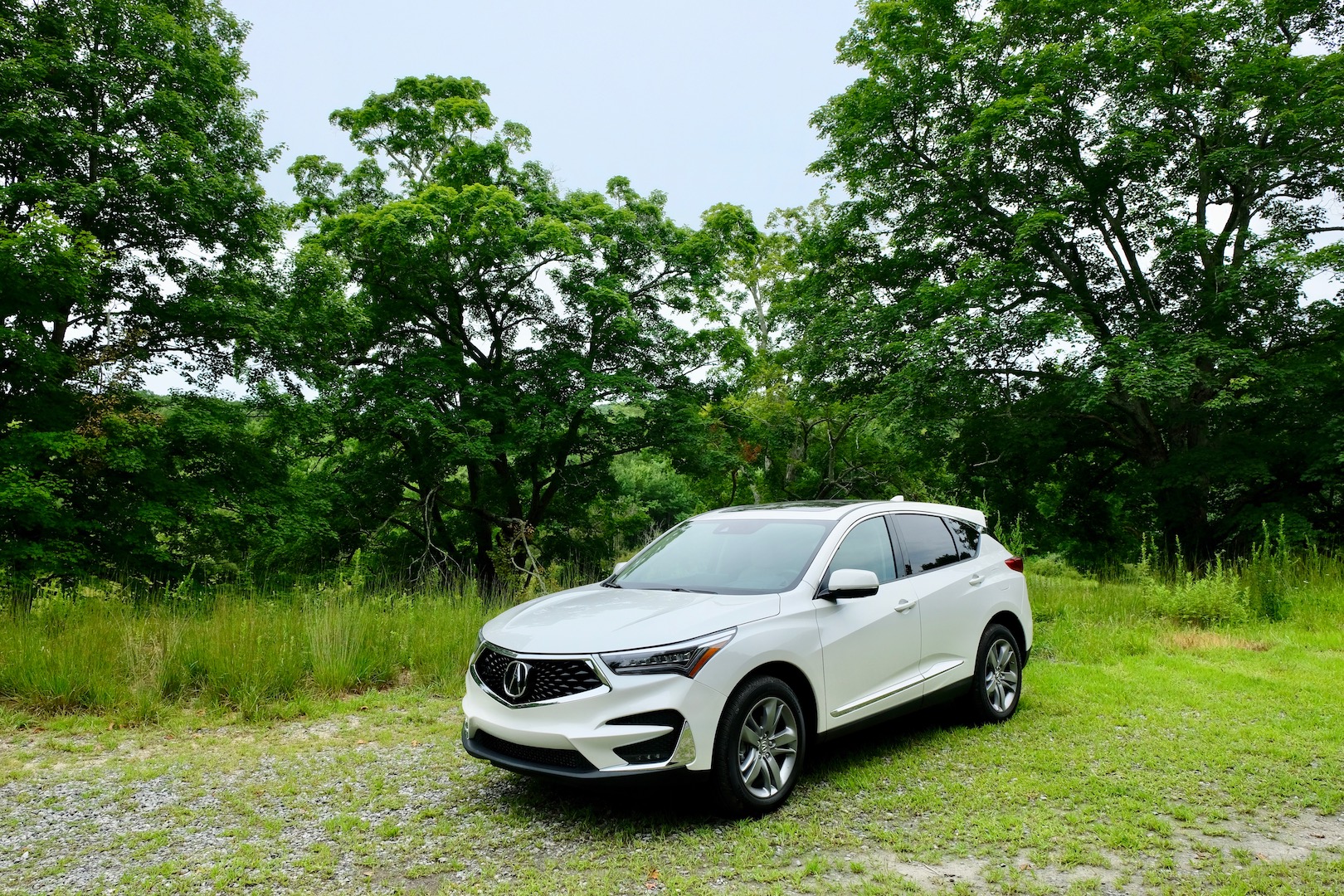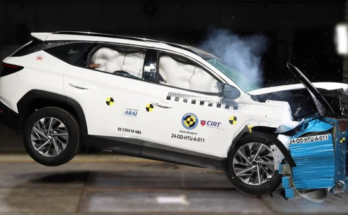When the first Acura RDX arrived in 2006, the idea of a small luxury SUV with a turbocharged four-cylinder engine was something of a novelty. How times change. Americans are all-too-familiar with that formula now, and Acura clearly wanted to go big to ensure that its third-generation RDX—among its most popular models— didn’t get lost in the SUV shuffle.
The 2019 RDX prototype (a showroom model in all but name) grabbed our attention at its auto show debut in Detroit last winter, where we first learned the previously porridge-bland SUV had received several dollops of styling, luxury and tech. American appetites were clearly whetted: The 2019 RDX— the vanguard of a new generation of Acura models—has exploded out of the gate. In June, its opening month in showrooms, the new RDX outsold every compact luxury SUV in America, its 7,292 sales smoking even the Mercedes-Benz GLC-Class, with its 6,608 units moved. The RDX also enjoyed the best sales month of any Acura SUV in history, and the most buyers for any Acura model since the TL sedan in April 2006.

Acura’s signature value surely had something to do with that. Starting from $38,205, the RDX undercuts the Mercedes GLC300’s base price by about $2,800. Even my RDX Advance—the top-shelf edition also packing a $2,000 upcharge for torque-vectoring, Super-Handling all-wheel-drive—checked out at $48,395. That price feels like a balm compared to some sticker-shocking compact SUVs, including the Alfa Romeo Stelvio and Mercedes-AMG GLC63, that can top $90,000. But beyond affordability, the RDX impresses by being Acura on its best day: A comforting Honda in terms of quality, smart engineering and sneaky-good performance, but with enough differentiation in design and luxury to make it feel not-a-Honda and thus worth the upcharge. (As such, that Acura chose the RDX to mark the return of its “Precision Crafted Performance” tagline seems fitting, not mere marketing fluff.)
That clear separation between the brands begins with the Acura’s all-new, stand-alone platform, with its preponderance of high-strength steel (60 percent of the total) and some 122 feet of structural adhesive. Acura claims an automotive-world first with its hot-stamped inner and outer door rings, which boost structural rigidity and are key to winning at crash tests like the IIHS small-overlap frontal test. A new “double ring” rear tailgate structure simultaneously anchors a new five-link rear suspension and provides for ultra-stiff performance by serving up multiple load paths for stress (including a thick member running below the cargo floor), while still allowing for an enormous tailgate opening.
The wheelbase grows by 2.6 inches, while an extra 2.2 inches in overall length brings the whole vehicle to 186.6 inches. There’s more room in both passenger rows, and noticeably more cargo space, including cleverly-managed underfloor storage brought about by moving the spare tire below the vehicle. An expansive panoramic sunroof is standard.

The last-gen RDX was simultaneously frumpy and nondescript. This one is more of an attention-getter, determined to prove it’s not just a Honda in a leather jacket. To that end, Acura designers at its Los Angeles studio enlarged the brand’s “diamond pentagon” grille, and borrowed from the stylistic doodle book that has inspired Lexus and other Japanese models: the “floating” roof that’s meant to suggest fastback adventure rather than family responsibility; the theatrical kabuki face with sweeping headlamps and jagged air inlets; the origami sheetmetal and boomerang, LED rear taillamps. A thick brushstroke of chrome underlines the doors, rendered in gloss black on A-Spec models. Is this RDX beautiful? Not quite. But it’s interesting, and that sure beats boring.
The interior is more conventionally luxurious, but it’s legitimately luxurious, in everything from materials to its stylish layout. There’s a warmth inside that Acura has rarely managed, including scallops of open-pore wood on my test model, a tastefully stacked-and-sculpted dash, and a floating, leather-trimmed center stack. Seats are simultaneously plush and supportive, with more stylish contouring and coverings than we’ve come to expect from Acura. Those included a pleasant surprise on my top-shelf Advance model: 16-way power seats whose adjustments included rib-squeezing side bolsters and a thigh extender, just like on fancy German rides.

There’s a huge 10.2-inch screen perched atop the dash, but don’t bother poking it: It’s not a touch screen, but part of Acura’s new technical calling card, called the True Touchpad Interface. (As Audi has MMI, for Multi-Media Interface, now Acura has TTI). Give Acura credit for guts…or something: The company’s surely seen that Lexus’s own Remote Touchpad is the most universally-reviled infotainment interface in the world today, in part because dragging a cursor around a screen proves nearly impossible to do while, you know, driving. Acura’s touchy-feely system has its own issues, including a steep learning curve, but it’s decisively better than Lexus’s, in everything from its interface to its splashy, modern graphics.
A Post-It size touchpad/drawing pad occupies the center console. Your finger traces the pad to select and control “apps” such as audio and navigation, but there’s no onscreen cursor to drag around the screen. Instead, the geography of the pad corresponds to what you see on screen. So if, say, the SiriusXM satellite radio app icon occupies the screen’s upper right, your fingers touch the corresponding space on the pad to highlight or select it—no mouse pad-like dragging required. A smaller, secondary touchpad controls a smaller, right-hand area of the screen. With the touchpad’s finger-friendly, Braille-like metal borders and subtly concave shape, it becomes surprisingly easy—in my case, after a week of practice—to glance sideways at the screen and intuitively perform your infotainment tasks.
You can also swipe the touchpad, smartphone-style, to move between screens or scroll audio presets, or use a two-finger gesture to travel through maps. As in many German cars, you can also draw letters on the pad, mainly to start navigation searches, but we all know few owners bother with that.

Not all controls are relegated to the new pad. Steering-wheel switches, voice commands, and a dashboard-mounted up/down changer for radio channels provide redundancy, and climate controls maintain their traditional hard switches. There’s an actual volume knob on the dash (which Acura and Honda had dumped in some models, before customers and critics screamed to get it back), plus “back” and “home” keys on the touchpad.
Still, the setup isn’t entirely hunky-dory. The system cries out for a few more hard keys for macros such as navigation, audio, and home, perhaps surrounding the touchpad in Germanic style rather than forcing you to swipe, scan, and select within screens. The screen sometimes ignores or misjudges gestures if you don’t perform them smoothly. The touchpad click could use a more pleasingly direct, less-squishy feel. The system processor seems a mite underpowered; the “core” navigation system took up to 15 seconds to load in some cases, with things like audio levels frozen until that was completed. New owners, especially less tech-savvy types, are going to need a serious dealership tutorial to avoid frustration. (Acura has such lessons planned.) And overall, I still think the True Touchpad demands more eyes-off-the-road time than necessary. Still, after a few days of my fiddling, damn if the screen didn’t start working quite effectively, especially compared with Lexus’s cursor-based abomination.

Once up to speed, in every sense, the RDX delivers on every SUV front: Roominess, comfort, confident performance and the slick optional Super Handling AWD system. Seats are simultaneously plush and supportive; the back bench is outstanding for this class, including a well-cushioned center perch that gives the RDX genuine five-passenger capability. A pair of handles in the cargo area drop the seats flat. There’s a large, rubberized storage tray tucked below the floating console— a bit more accessible than the ones in various Volvo models—with a USB port and power outlet. Big cupholders up front can handle super-sized beverages, though they could also use a spring-loaded spacer to keep skinnier thermoses from rattling around.
And now, a word from Honda, whose under-the-skin contributions are key to this RDX’s overall goodness. (And a memo to President Trump, in case he thinks Honda imports all this stuff). A hat tip to Honda R&D in Raymond, Ohio, where major development took place; to Anna, Ohio, source of the turbocharged, 2.0-liter four-cylinder that’s closely related to the Accord sedan’s; and to Russells Point, Ohio and Tallapoosa, Georgia, the respective loci of the AWD system and 10-speed automatic transmission. That turbo four’s 272 horsepower is seven fewer than the previous RDX’s 3.5-liter V6, but the 280 pound-feet of torque whomps the six-pot’s 252. Just as importantly, the four-cylinder is generating 40 percent more torque at a low 1,600 rpm.
This is a better class of four-banger than what you’ll find in a competing Lexus, Infiniti, Volvo, or even Mercedes, and in the conversation alongside the best turbo fours from Audi or BMW. Despite an occasional heartbeat of delay, the 10-speed transmission always finds the right gear, thanks in part to the ability to downshift four speeds in one fell swoop. (I’m still no fan of the 10-speed’s transmission controls: There’s one button for park, another for drive, a little scalloped-out toggle for reverse, and all three switches seem to have nothing to say to each other.) DIY-types can use the paddle shifters, but either way, this RDX actually likes to rev, and it’s deceptively quick: Figure about 5.8 seconds from 0 to 60 miles per hour, a good half-second quicker than the previous V6 model. The engine can’t match the hustle of the 306-hp version in the Civic Type R, but the addition of balance shafts makes it silkier and quieter. In some competing vehicles, the four-cylinder strain would show, but Honda’s four-banger is so smooth that you rarely feel gypped over the lack of a six.

The demure sound is subtly enhanced via the audio system. To enhance actual music, opt for the uplevel ELS audio system (standard on sporty A-Spec and Advance models) which Acura is calling its best aural experience yet. The sparkling ELS unit was tuned by Grammy-winning producer and engineer Elliott Scheiner—an interesting guy, who I met when he first worked with Acura. The 710-watt, 16 speaker system (including four overhead speakers) is standard on RDX A-Spec and Advance models, and it’s a nice change-up from premium audio systems that add several thousand dollars to a car’s price.
As for the appropriate soundtrack for the RDX’s personality, it’s neither Muzak nor hardcore punk. It’s more like yacht rock, with the Acura poised in the comfortable, mainstream middle: Sportier than a Lexus, Lincoln or Volvo XC60, less aggressive than an Alfa Romeo Stelvio or BMW X3, and about even with an Audi Q5 or Mercedes GLC-Class. Like the Accord, the RDX is always confident, and surprisingly capable on twisty roads, even if it never seems to be exerting itself or “trying” to have fun.

The torque-vectoring AWD system can send up to 70 percent of power to rear wheels, and up to 100 percent of that to either rear wheel to help the Acura maintain traction and pivot around corners. As ever, the “Super Handling” system isn’t especially showy in operation, but it really gets the job done: You will trash every speed limit in sight before you encounter understeer.
The RDX tries to bump up those sporty perceptions with a silver dynamic-selector knob, smack in the middle of the center stack. The RDX even defaults to Sport mode, dialing up sporty settings for its throttle mapping, transmission, AWD and (on uplevel models) adaptive dampers. Yet ironically, the Acura’s most prominent hard switch is the one owners are least likely to use: They’ll be thrilled with how confidently their RDX handles, but they won’t be looking to terrorize any subdivisions. The ride is serene, if not as quiet overall as in some German luxury models, and body roll is impeccably managed. Sport Plus may seem a bit hectic for owners raised on softer SUVs, with its aggressive throttle response and refusal to shift until redline.
Now, if Acura could just coax some feedback through the steering wheel—it’s pretty much AWOL—the RDX might feel more full-on engaging. (That variable-ratio steering is easeful, though, and makes it easy to negotiate tight quarters.) The Lexus-soft brake pedal is the only real misstep in terms of dynamic tuning; there’s simply too much pedal travel before you get any initial bite, as I learned to my dismay when an Uber driver cut me off in Manhattan traffic.

The EPA pegs fuel economy at 22/28 mpg for front-drive models, with AWD dinging it to 21/27 mpg. (Big-tired A-Spec models suffer another 1-mpg handicap). My RDX also bristled with every driver-assistance feature that Honda engineers can throw at it, including automated front braking and adaptive cruise control with a touch of lane-keeping assistance through the steering. The Advance model, the highest of four trim levels, includes a hands-free power tailgate and surround view cameras; a huge 10.2-inch head-up display, rain-sensing wipers, heated rear seats, and ventilated front seats. My RDX SH-AWD Advance model stayed just under the $50,000 mark, coming in at $48,395. But you can go easier on the gear and still have an Acura-made luxury SUV no one will ever confuse with a Honda CR-V for around $40,000.
But again, let’s not dog Honda: As its opening-month reception from consumers suggests, this RDX is playing a familiar hand of value, engineering, capability, tech and luxury, even as it plays its Honda-dealt cards close to its vest. When the RDX gets a full calendar year of sales under its belt in 2019, don’t be surprised if it claims the pot as America’s most popular compact luxury SUV.
Lawrence Ulrich, The Drive’s chief auto critic, is an award-winning auto journalist and former chief auto critic for The New York Times and Detroit Free Press. The Detroit native and Brooklyn gentrifier owns a troubled ’93 Mazda RX-7 R1, but may want to give it a good home. Email him at Lawrence@thedrive.com.



